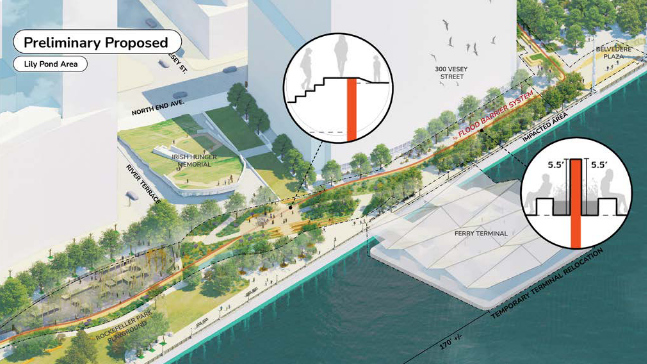New York state’s Battery Park City Authority is advancing plans for one of several key resilience projects aimed at protecting lower Manhattan against flooding associated with anticipated sea level rise.
The authority recently awarded a contract for the progressive design-build North/West Battery Park City Resilience Project to a joint venture of Turner Construction Co. and E.E. Cruz & Co. Inc. with Arcadis, Bjarke Ingels Group, Scape Landscape Architecture and WSP. Construction is expected to start next year, the authority says.
The project covers an area along the Hudson River waterfront between the northwest end of Battery Park and a high point on Greenwich Street in Tribeca. Design is still underway, but preliminary plans call for about 8,000 linear ft of flood and seepage barriers, plus interior drainage improvements to protect a 92-acre area, the contractors said in a statement.
 The North/West Battery Park City Resiliency Project would synergize with others around Lower Manhattan.
The North/West Battery Park City Resiliency Project would synergize with others around Lower Manhattan. Drawing courtesy of BPCA
The authority says deployable floodgates are a likely barrier solution for the project. Most of the Battery Park City shoreline is at the furthest point allowed for the federal navigation channel in the Hudson River, so any construction into the river would be far more complex and costly, officials say.
Officials say they cannot yet share an expected cost for the project with design still underway.
Sea level rise presents “a serious threat” to the area, says Peter Glus, North American growth director at Arcadis and the firm's lead design engineer on the project. During Hurricane Sandy in 2012, many parts of the Lower West Side were impacted by storm surge.
But the Battery Park City esplanade is also a busy area for commuters, tourists and residents who use its waterfront parks. Glus says the team holds weekly meetings with residents to get their feedback on design options. The goal is to make a project that provides benefits during storms and during other times, amplifying the area’s current uses and preserving its design aesthetic, he says.
“There’s been a robust engagement because the authority’s residents are very much cognizant that this project is going to be built on a renowned and trendsetting waterfront area,” Glus says. “The Battery Park City Authority’s property really established what coastal urban life could be like. And right now what we’re trying to do is evolve that concept so that it’s coastal-resilient urban life.”
The project area is located between two other authority-managed resilience projects. Site preparation work for the South Battery Park City Resiliency Project started late last year, with contractors E.W. Howell and a joint venture of Posillico Inc. and Bove Industries selected. A third contractor has not yet been named, an agency spokesperson says. The project, expected to cost at least $221 million, was designed by AECOM. At the northern end of Battery Park City, contractor Speciality Construction Services completed the $7-million BCP Ball Fields and Community Center Resilience Project in 2021.
The three BPCA projects are part of the city’s Lower Manhattan Coastal Resiliency Project that circles the southern end of Manhattan and continues north along the East Side, with projects protecting the Financial District and Seaport, Two Bridges neighborhood and north to East 25th St.
Manhattan’s density creates unique engineering challenges for flood protection efforts, Glus says. While the various projects have different owner-agencies, they collaborate through the mayor’s office on issues such as performance criteria and collaboration.
Taken together, the projects are “unprecedented,” adds Glus, who also is project director of the Eastside Coastal Resiliency Project.





